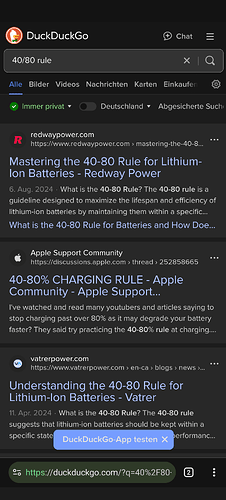I read a non-FP advice to improve battery life: charge until 80%, use until 20%.
Will that help my FP5 battery?
Greets
Yup, there is the “40/80 rule” for Li-ion batteries, so 40 - 80% is the most healthy charging-level-range.
The actuel rule is 20/80, not 40/80.
You can even programme your FP5 to stop loading at 80%. You find the android battery settings.
Cheers
I don’t know where you got this from. But I just googled it and there where no results, with the excpetion of a 80/20 rule called the pareto principle, which doen’t have to do anything with batteries.
In fact, not a single result was found about batteries. While when I look up 40/80 rule, all results are about batteries and said rule. I think you confused something.
You should try again.
https://duckduckgo.com/?q=20%2F80%20rule%20battery&t=h_&ia=web
You didn’t include ‘battery’.
The rule is called “40/80 rule”, not “40/80 rule-battery”. Lol. Look, still did not search battery but found the rule…
If you really want to die on that hill… You do you, but to me it is 100% clear it is not 20/80.
Okay, the problem is that some aeticle says that it’s 20/80 percent (Apple for example) some says it is 40/80 (like vatrerpower)
So which one is it and why?
Don’t switch, @Switch. We were talking about 20/80.
There is just nothing like “that one rule” and both exist and for morst people 40/80 isnt really a practical approach I guess.
So overall I think we can agree its better to not charge to 100 and def dont let it discharge completely to avoid deep discharge and everyone can inform themselves and use what they find usable. So @harricot and @Switch please stop this kind of “discussion”.
People in largest hardware chat room told me keep lithium-ion batteries between 30% to 70%, so I’ve had some last years… notice its 20% on each side of 50%. However, you can’t do this unless you root (get administrator access) it and install something such as Advanced Charging Controller (ACCA) but otherwise, built-in option to limit it to 80% is close enough to work almost as well.
Thanks, all of you.
Next question: will it make a big difference, using either rule, or let it go from 100% to 0%. How much battery lifespan will we win?
The charge and discharge rate has a much greater influence on the life cycle than the limitation of the charging capacity. In addition, every battery has charging electronics and any additional “charging control” would have to adapt to this in order to achieve any effect. For example, the state “100% fully charged” is not fixed but results from the behavior of the battery in certain charging/discharging states.
https://www.tandfonline.com/doi/full/10.1080/14786451.2024.2337439#abstract
If that is the case, if the number of chargings is the major influence, then it would be better to charge to 100% and discharge to 0%. In that way, you get a lower number of chargings in comparison to charging between 20 and 80%.
Or do I miss something?
That’s what I would think too.
The capacity limitation (20/80 or similar) is probably only interesting for people who can’t do without very fast charging/discharging (RC models or something like that)?
My battery is 1.5 years old and is currently at 90% with normal daily charging (0/100). I would think that is a good value?
OT: There are no results for 20/80 rule is all I said and I proved it. He moved the goalpost (twice) and says “ha, WRONG”. That’s not a discussion, that’s just nonsense of which I won’t be a part of, so no worries. ![]()
It is not about how often you charge but how long and with which power. So charge with little power and stick within the 40-80 range (20-80 should be fine too ![]() ) and you’re good. I did this with my FP3 for 3 years and had a perfectly fine battery, I even sold the battery afterwards.
) and you’re good. I did this with my FP3 for 3 years and had a perfectly fine battery, I even sold the battery afterwards.
Well, in fact, using fast chargers wears out the battery faster. Probably, charging to 100% slowly is better than doing it fast following the max 80% rule. I don’t know. I am charging all my devices to 100% and most of the time slow, during the night, and the battery still performs as new after three years.
Here I leave this: Testing fast charging damage to smartphone batteries | Arduino Blog

